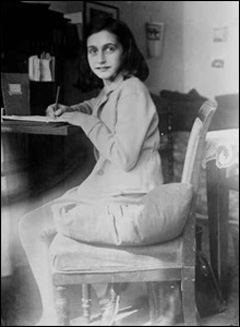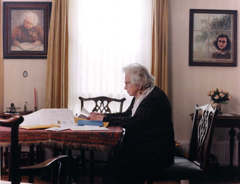
Anne Frank writing at her desk at home at the Merwedeplein, 1941The Secret Annex contains the collected diary entries that Anne Frank wrote between June 12, 1942 and August 1, 1944. The diary offers a window on the thoughts and feelings of an ordinary pubescent girl, living in an extraordinary situation: together with her parents and sister, one other family with a son her own age, and an elderly dentist, she spent more than 2 years living in hiding, invisible to the outside world, hoping to escape the inhumane fate that the Nazis had devised for Jews. Anne Frank describes, often humorously, sometimes touchingly, her sympathies and antipathies, her anxieties, her plans for the future, the events in the Secret Annex and her artificially restricted view of events in the rest of the world. The hiders had to depend on a small group of loyal helpers who provided them with food and other necessities, with information about the war's progress, and who also offered indispensable distraction, a breath of fresh air from the world outside.
Miep Gies and her husband Jan were part of this small group of helpers. The American author and journalist Alison Leslie Gold helped Miep Gies put her memories to paper, and so in 1987, forty years after the publication of The Secret Annex, the book Anne Frank remembered. The story of the woman who helped to hide the Frank family, was published. The Dutch version followed later that year, with the title Herinneringen aan Anne Frank. Het verhaal van Miep Gies, de steun en toeverlaat van de familie Frank in het Achterhuis. Miep Gies describes the rise of fascism in Europe, the direct impact on daily life of the German occupation of the Netherlands, and the growing impotence in face of the steadily more oppressive measures that made life for Jews increasingly hard. Miep Gies therefore did not hesitate for a second when Otto Frank asked her to help his family in their plans to go into hiding in the rear annex of his office premises at Prinsengracht 263 in Amsterdam, where Miep Gies had been working for him as a secretary since 1933. 
Miep Gies at home reading, Juni 2001. Photo: Bettina Flitner.Miep Gies had known the Frank family since 1933, and all those years Otto Frank had been her employer. Miep and Jan were often invited by Otto Frank and his wife Edith to informal Saturday afternoon gatherings, where they also met other friends of the Frank family. In this way, Miep and Jan got to know the family increasingly well. Miep Gies wrote her book with great compassion for the family, while at the same time there was the inevitable distance, due to the simple fact that Miep was a visitor to the Secret Annex, and not an occupant.
The book by Miep Gies complements the diaries of Anne Frank. Anne starts writing at the moment that the family moves to the Secret Annex, and her last entry dates from three days before their betrayal. Miep Gies also describes the period that precedes their going into hiding, and relates the sad fate of the Secret Annex occupants after the betrayal. Looking back after many years, Miep Gies is able to provide a context and an overview that Anne could not, given her position on the inside. Miep Gies also recounts how she presented Anne's writings to her father in the summer of 1945, saying 'This is the legacy of your daughter', and all that happened from then on.
Yet Anne Frank and Miep Gies also write about the same events, situations and people, each from their own perspective. Below you will find a number of excerpts from the books of Anne Frank and Miep Gies that complement one another, thereby creating an even more vivid picture of the past.


